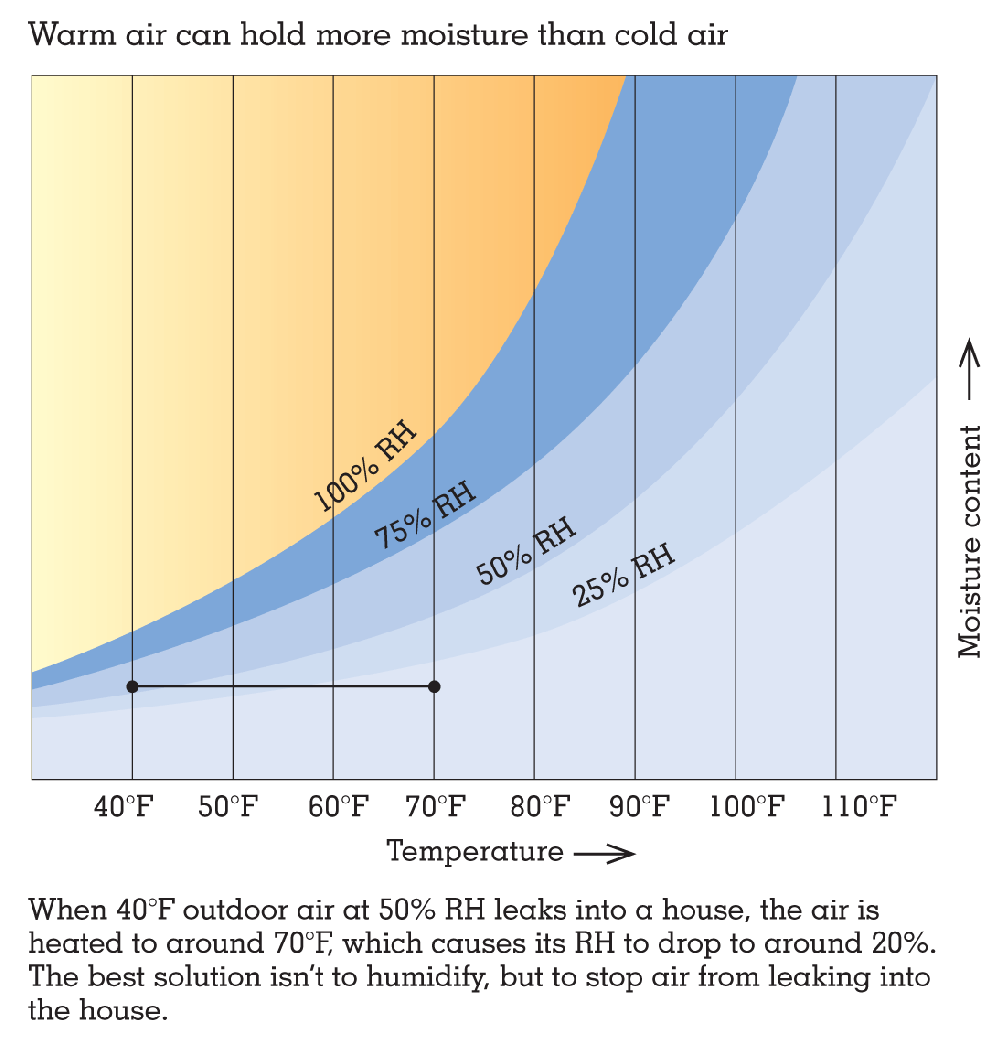
_This podcast series is excerpted from a two-day class called “Building Science Fundamentals” taught by Dr. Joe Lstiburek and Dr. John Straube, of Building Science Corporation._
For information on attending a live class, go to BuildingScienceSeminars.com
Last week Dr. John covered the common causes of air movement in buildings and touched on the consequences. This week, Dr. John goes into more detail on the issue of air leakage condensation.
This two-part podcast series on how air works has been refined into a feature article, called Air leaks Waste Energy and Rot Houses
. It is the new ‘Air Barriers’ section of the Green Building Encyclopedia.
__________________________________________________
Why should we care about relative humidity?
So basically if moist air contacts a cool surface condensation will occur. And an air barrier is one way of stopping humid air from getting to cold surfaces, because in any building in cold weather you will have a cold surface. The cladding, the exterior sheathing—and if indoor air can contact that cladding or sheathing, condensation can occur. So what we’re trying to do when we’re installing an air barrier is to prevent that cold surface from being in connection with humid air.
So we need to understand a little bit here about water vapor to go a little bit further and quantify this. Water vapor in air has a maximum storage capacity, if you will, depending on temperature. Warm air can store lots of moisture as vapor in the air; cold air can store only very little. And that is summarized in the psychrometric chart. How many people have seen the psychopathic chart? Most people have. Willis Carrier, from Carrier Air Conditioning, invented this in 1904.
How to look at air moisture content
If you want to understand psychrometrics you only need three lines actually. You need to know that the vertical axis is the moisture content. The units don’t really matter; we can measure them in a whole bunch of ways; but it’s the air moisture content. It’s measured in things like it in ounces of water per cubic yard—very rarely, because that actually has some physical meaning to most humans. Whereas what mechanical engineers like to use, and it’s questionable if they’re even a subset of humanity, they like to use inches of mercury, or grains of moisture per pound of air. So how much is ten grains of moisture? And how much really is a pound of air? Those are completely meaningless physical units to most of us. And so everyone blanks out and doesn’t understand because they’re not given real units. But actually the good news is that you don’t even have to care what the units are—for most of the work. On the bottom I have temperature, which is obviously important, and the third thing that matters is the maximum moisture content that air can have as a function of temperature. As we go from 90 degrees down to 20 degrees, the amount of moisture that can be stored in the air changes by about an order of magnitude—a factor of 10. That’s a big change. So this is like a gas tank that shrinks, as the temperature gets colder. So when it’s hot you can store a lot in this tank, but when it’s cold you can’t store much at all. And if you were to have a large gas tank filled with gas and you shrunk it, eventually, you’d fill up and spill over. And that’s condensation.
Now if air is completely saturated, completely full, they call that saturated air. They also have these neat terms that if it’s half full the air is 50% relative humidity. And if it’s one quarter full they call that 25%. And if it’s three quarters full, it’s 75%. Right? So that’s what that means, it’s how full it is. Just 50% relative humidity or 75% relative humidity doesn’t tell me how much moisture’s in the air, it only tells me how close I am to full. So if I want to know what the actual moisture in the air is I need to know both the temperature and the relative humidity. If I put those two pieces together—temperature, relative humidity—then I can go across and figure out how much moisture I have in that air.
Living in homes makes them wetter
Another important aspect to understanding this chart is that here’s a typical wintertime condition in Kansas, or in Minneapolis, or in Boston: it’s around freezing outside—30 degrees, 32 degrees; and it’s snowing. And because it’s snowing it means that the relative humidity outdoors is 100%. If you sprinkle water all over the air for a long time, it’s fully saturated. Right? That’s how it works. So if I take that air, and I heat it up and bring it into the building, like I’d like to do on a cold day—heat it up to 72 degrees—the amount of moisture in the air stays exactly the same. All I did was heat it. I didn’t add any moisture; I’m just heating it. But because the storage capacity of the air has increased with temperature, the relative humidity drops. And we can get down to under 25% relative humidity. But, we don’t just leave it there. Most of us do stuff like: breathe; and produce moisture and sweat; some people actually boil cabbage, and spaghetti; and vent their clothes dryers into their homes to save energy; or dry a cord of freshly cut lumber in the basement of their house—which means all that moisture is being dumped in; or grow pharmaceutical plants in one of the bedrooms under lights; and all of that generates moisture. And, therefore, as we add moisture, the relative humidity rises. And the absolute moisture content rises as well. Both relative and absolute humidity move.
Why is indoor humidity a problem?
Well, it matters in that now as that air leaks out of the building, and it passes thorough the building enclosure, If it sees a surface colder than say 52, 53 degrees in this example, it will reach its full capacity to store moisture, and after that condensation will ensue. And so if the cladding is somewhere around 30 degrees, as well as the outdoor air temperature, the air, if it were to contact the outside sheathing, would drop all of this moisture, that it gained, on the way out, and it would dump it on the cold sheathing surface. So that’s a typical air leakage condensation cycle that we’re trying to avoid. It’s absolutely that straightforward. This, by the way has nothing to do with vapor barriers. It has nothing to do with vapor diffusion. It has to do with a packet of air—one cubic foot of air—that I actually take, and I push it through that hole in the wall, and it gets cool. And as long as it gets cool, it’s going to follow this chart. So how can I avoid it getting cool and condensing? Well one thing is I can shoot it through that hole so fast that it goes outside before it cools down. And then we see fog coming out. That’s what we see when we have a natural gas furnace or something like that. They fire that stuff out and you see this fog forming in the air next to it. Well when you breathe on a cold winter pretty day, you’re producing humid air, and it right away fogs up. If on the other hand, you take your woolen mitts and blow the air slowly into them, it’ll condense on the inside and it’ll be a really yucky stinky mitt, because it will have all my fog in it. Right? So that’s what I used to do to my sisters, I used to blow into their wool en mitts—see I learned that about building science when I was about 6, and I learned the whole air leakage condensation thing.
Air conditioning causes condensation on the inside
The same thing happens in reverse in the summertime. Let’s say the outside conditions are 85 degrees and pretty humid—75% relative humidity. If that outdoor air leaks inward until it contacts a surface below about 76 degrees it will condense.
So how many of us work in areas where it can be more then 86 degrees and 75% humidity in the summertime? I mean I certainly do in Toronto. Buffalo, Minneapolis—basically the rule is that anything that’s east of the Mississippi you should expect to have a significant number of hours above 75 degrees and 75% relative humidity. And if you’re further south in that zone, you’re not just going to have 500 hours a summer; on the Gulf Coast there are 3000 hours a year. You know, a third of the year is above those conditions. So if you are actually going to have an exhaust fan in one of those hotels Joe described, and build it in Galveston Texas, you’re truly screwed, because all that air leaking in is going to condense on all the air conditioned surfaces it can see. Now hopefully the only air you draw in goes through your air conditioner because then the first cold surfaces it sees are the coils on your air conditioner, and that condenses the moisture off where you have control. But if it leaks in through the wall or through the roof or in that entrance canopy on the hospital, that’s not good.
Leaky homes didn’t have this problem
Now here’s something that’s important about the cold weather condition. Many times we didn’t have problems with air leakage in cold weather because our buildings were so well ventilated—meaning leaky—that the relative humidity in the home would rarely rise above 25%. So where I grew up, in an old farm house, it was leaky like crazy; we had two wood stoves in it that ventilated the home; it was so dry that my eyeballs would shrivel up and hang by the optic nerves during the whole cold period of the winter.
As we have tightened up homes and not provided guaranteed ventilation, the result has been that the relative humidity has gone up. Then the amount of moisture in the air, in absolute terms, and the amount of condensation that can occur is dramatically different. And it’s not just condensation on the exterior sheathing, it’s now condensation on the inside face of the window; it’s now condensation inside the wall, wherever it can find a cold spot. So not having control of your indoor humidity in cold weather is amazingly important to how much condensation you get for how long, and weather or not you get it at all. And very dry interiors have saved us for a long time, allowing us to ignore this problem.
Is there air leakage condensation in my home?
If air leaks through, you usually can’t see the condensation, unless you’re a forensic engineer like Joe and I, and you go around and cut holes in walls. It can happen in walls, it’s just that we don’t often get to see inside. But we know it happens. But, where you get to see it a lot is in attics, because all you have to do is pop the hatch and see the frost forming on the underside of the OSB or plywood sheathing. And it doesn’t take much of a hole in a humid house to result in the condensation accumulating as frost. And then when the sun comes, warms up this black shingle roof, of course the water all comes out in a couple of hours, and then you have a “roof leak”. Then you call the roofer and he puts on a new roof and it doesn’t fix a damn thing because that wasn’t the problem.
Weekly Newsletter
Get building science and energy efficiency advice, plus special offers, in your inbox.















0 Comments
Log in or create an account to post a comment.
Sign up Log in